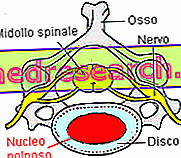Cervical hernia (more precisely defined as a hernia of the cervical disc ) is a leakage of more or less extended portions of jelly discal substance from its natural anatomical borders.

What to do
- Wear a soft cervical collar to protect the cervical spine
- In case of failure of conservative therapy (physiotherapy exercises and administration of painkillers / anti-inflammatory drugs) it is possible to undergo a targeted surgery (discectomy)
- Follow a pharmacological path always in association with a specific physiotherapy therapy; this approach is suitable for accelerating healing times from a mild cervical hernia
- Even after having achieved an improvement in pain, it is suggested to undertake a rehabilitation process aimed at maximizing the general health of the back, useful for preventing further future damage to the cervical spine
- Surgical therapy to remedy cervical hernia is indicated when the characteristic symptoms of herniation last over 3 months
- Contact your doctor immediately if you are unable to move or move your neck
- If necessary, use the cervical collar during the post-operative period
- Acupuncture: alternative remedy useful for relieving pain caused by a cervical hernia
- Perform specific massages on the cervical spine, performed by experienced and qualified personnel
- Osteopathic treatment, useful for alleviating any nerve impairment in the cervical area
- Correct any incorrect life habits (eg incorrect posture, positions of tension during sleep, etc.)
- A good remedy that can temporarily alleviate the pain of a cervical hernia is to perform compresses on the spine area involved. Start first with fresh packs; after a couple of days it is suggested to make hot compresses
What NOT to do
- Lift heavy loads during cervical pain
- Undertake a new "do-it-yourself" sports training: if performed incorrectly and undisciplined, power sports - such as bodybuilding - can be very harmful to the cervical spine
- Smoking: smoking can extend healing time from a disc herniation after surgery. It is therefore advisable to stop smoking
- Temporeggiare: when a herniated cervical disc is suspected, it is recommended to immediately consult a doctor to start any conservative treatment as soon as possible
- Stop the medical (pharmacological) treatment after the first improvements: the therapy should be continued for at least a couple of months
- Assume malicious positions
- Drive after a discectomy surgery
- Administer aspirin to children under the age of 12: similar behavior can cause serious side effects, such as Reye's syndrome, liver dysfunction and brain changes
- Excessive rest: even prolonged rest does not help cervical pain. An excess of rest indeed favors the stiffness of the joints and muscles, already weakened in itself. Rather, take a restful position for 30 minutes; after which we recommend a walk or a light physiotherapy exercise, specific for cervical pain
What to Eat and What NOT to Eat
There is no scientific evidence that relates food to the improvement or worsening of cervical hernia symptoms. It is recommended to follow a healthy diet, rich in fruit, vegetables and low in fat. After a possible surgical intervention, it is recommended to follow a light and balanced diet, suggested by the nutritionist or by a competent health figure.
Natural Cures and Remedies
Natural remedies for cervical hernia can be used as a complement to drug therapy. Used in monotherapy, natural extracts are not very effective, given the intensity of the pain that accompanies the cervical hernia. Relaxing herbal teas can help the patient to be less tense in some way: we remember that cervical pain tends to be accentuated even in case of tension or strong stress.
Furthermore, the pain caused by the cervical hernia can create serious problems in falling asleep: in similar circumstances, it is recommended to administer herbal teas formulated with drugs with sedative anxiolytic action:
- Valeriana ( Valeriana officinalis ) → hypnotic, anticonvulsive, sedative properties of the central nervous system
- Passiflora ( Passiflora incarnata L.) → anxiolytic, sedative properties
- Chamomile ( Chamomilla recutita ) → mild anxiolytic and sedative properties
- Lemon balm ( Melissa officinalis ) → antispasmodic, sedative properties
Pharmacological care
The main goal of drug therapy is to reduce cervical pain. For this purpose, the most used drugs in therapy are:
- NSAIDs (non-steroidal anti-inflammatory drugs):
- Ibuprofen (eg. Brufen, Moment, Subitene)
- Acetylsalicylic acid (eg Aspirin, salicin, Vivin C, Ascriptin)
- Naproxen (Aleve, Naprosyn, Prexan, Naprius)
- Muscle relaxants: excellent remedy to calm the muscle spasms generated by the cervical hernia:
- Diazepam (Micropam, Ansiolin, Diazepam FN, Valpinax)
- Ciclobenzaprina (eg Flexiban)
- Corticosteroid drugs: exert a powerful anti-inflammatory activity:
- Prednisone (eg. Deltacortene, Lodotra)
- Methylprednisolone (eg, Solu-medrol, Depo-medrol, Medrol, Urbason)
- Opioid painkillers: when the pain is too intense. They are taken orally.
- Hydrocodone: for example Vicodin (not sold in Italy).
Prevention
- Do not lift heavy loads during cervical pain: this behavior increases the risk of hernia, both cervical and abdominal (eg inguinal hernia)
- The strengthening of the cervical muscles involved in a previous herniation is essential to prevent possible future damage. Physical therapy exercises must always be performed correctly: only by respecting the conditions suggested by the physiotherapist, or by an expert on the subject, can they bring real benefits to the subject
- Before starting any targeted training program (eg weight lifting), the advice of a qualified doctor or instructor is recommended, in order to prevent any muscle tears or injuries, the main defendants in the herniated disc
- Respect rest in case of severe cervical pain, to prevent sudden tears or movements that could favor the onset or aggravation of the cervical hernia
Medical treatments
- In case of failure of conservative therapy, or persistent and ferocious cervical pain, the patient undergoes surgical therapy:
- Anterior discectomy (the most widely used surgical remedy for the treatment of cervical hernia)
- Posterior discectomy: surgical treatment reserved exclusively for lateral cervical hernias
- Alternative therapies: some patients are subjected to "innovative" therapies:
- Oxygen-ozone therapy: involves the introduction of an oxygen / ozone mixture in the interdiscal area. In fact, ozone exerts a discreet anti-inflammatory power reducing the disc pressure.
- Coblation ( vaporization of the cervical disc herniated with the laser). Indicated to treat small cervical hernias, in the absence of severe muscular deficits.



